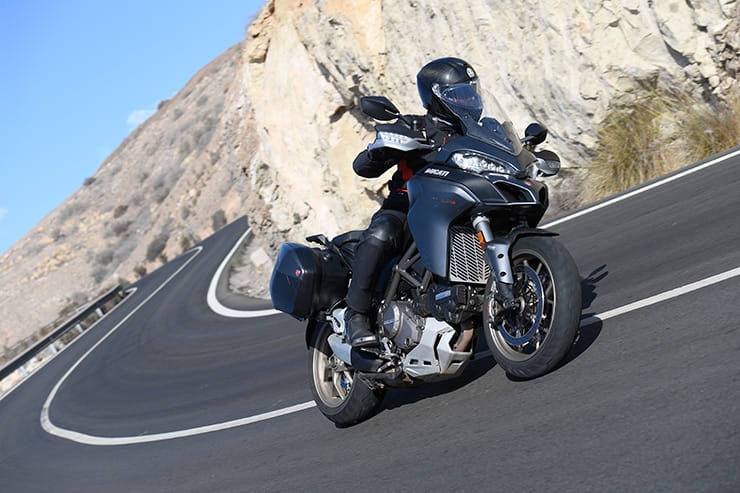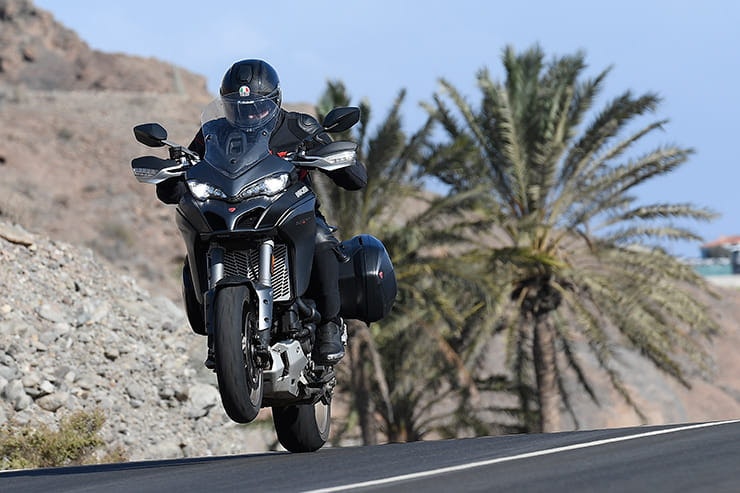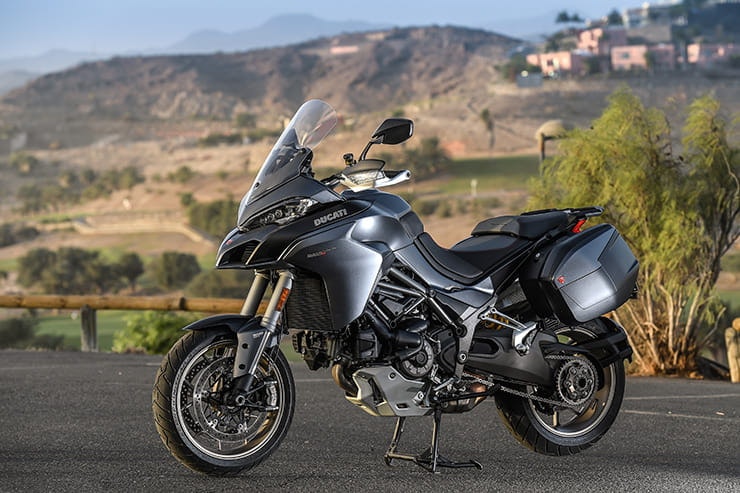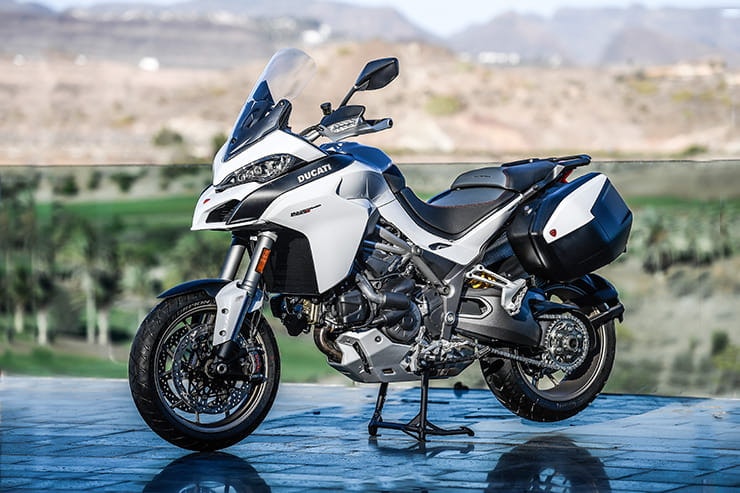Ducati Multistrada 1260 S (2018) - Review
By Michael Mann
BikeSocial Managing Editor
15.12.2017
Multistrada. It means ‘many roads’ in Italian. Good job too because on the press launch in Gran Canaria that’s certainly what was experienced…and the latest version of Ducati’s sports tourer not only stood up to the challenge but passed with flying colours.
The Canary Island offered all seasons in one day; from the 23-degree glorious sunshine and smooth, silky, sweeping mountain passes to the howling wind, rain and mist/fog/low cloud combination at 2,000m above sea level leaving the road covered in tree debris and rocks the size of melons. It meant the range of riding modes were tested as was the screen’s protection and heated grips. It was as if Ducati had planned the weather.
Ducati Multistrada 1260 S | Launch highlights
Bigger, faster and laden new top-end tech
What’s new?
For 2018, Ducati’s lanky sports bike continues to tick the comfort, performance and high-end technology boxes, and it gets a host of upgrades to boot. Over the outgoing 1200 model which has been around since 2010, the new 1262cc-powered version is bigger and faster, the torque is more useable and there’s a heap of rider aids and electronics improvements too. A 6bhp increase takes it up to a peak of 156bhp @ 9500rpm and while the peak torque power figure shows only a slight increase, it’s the increase in drive across the most used part of the rev range that shows the most significant increase...85% of the max torque (129 Nm/95 ft-lbs) available at just 3,500rpm making overtaking a cinch without requiring a down change.
The new bike is available in four varieties, are in dealerships now and have these price tags attached:
Multistrada 1260: from £14,295
Multistrada 1260 S: from £17,195. Volcano Grey is an extra £200 at £17,395 (the bike I tested also had the Touring Pack: heated grips, a centre stand and panniers = £18,349 plus a radiator guard for all those melons)
Multistrada 1260 D|Air: £17,895
Multistrada 1260 Pikes Peak: £20,795. All four models will be in dealerships before the end of December.
All four Ducati Multistrada 1260 models
The new DVT 1262cc engine, based on that from the XDiavel, increases capacity with a longer piston stroke and therefore new conrods, crankshaft and cylinders. The Desmodronic Variable Timing system has been recalibrated while the exhaust and intake have also been redesigned.
Other changes include a new ride-by-wire system, a longer swing arm and therefore wheelbase plus revised geometry up font with an increased rake and trail adds stability and improves handling.
Each bike has a host of modern technology rammed into it too including keyless ignition, cruise control, four adjustable riding modes, backlit handlebar switches, cornering ABS and a new tyre pressure monitoring system – and is now more than a match to the GS level of spec. While on the S model you also get the advanced TFT display and multimedia system allowing for Bluetooth connectivity with your phone, cornering lights, LED headlight, quickshifter up and down plus the Skyhook Evo suspension which has electronic compression and rebound damping on the front and rear.
There are even new and lighter weight wheels, a new set of grab handles for the pillion plus a forthcoming free app (around February on iOS and Android) to show data recordings, ride information plus service parameters – 9,000 miles for each service and 18,000 for each valve clearance check.
What’s it like to ride?
The throttle reaction with the new ride-by-wire system is quicker although still a little jerky at low rpm, primarily in Sport mode. We endured many tight switchbacks on our 160-mile trek up and then back down the mountain roads which highlighted the change of direction ease and lightness of steering but also showed the abrupt on/off throttle response in first gear.
Nevertheless, on the faster corners, the throttle is smooth and aches for a slight twist of power to show off the bikes sportier nature. In fact, the entire throttle twist action from off to maximum is short and emphasises control. The chassis refinements have, apparently, led to improved handling characteristics and while the outgoing Multistrada was hardy a slouch in the corners (it’d behave remarkably on a track day, according to a former colleague), the new version has an even better front-end. In the quicker left/right corner combinations, this key weapon in the Ducati’s arsenal became even more evident. With Sports mode engaged and trust in the Pirelli Scorpion Trail 2’s on the now dry roads, I pushed on never once feeling unsettled or wobbly on the pannier-laden 235kg machine.
The new TFT display interface is ace. Easy to read, clear, bright thanks to its high resolution. It automatically reverses from black on white to the other way around when in a tunnel or as day turns to night. The new menu function operated via the left bar-mounted rocker switch is very intuitive, despite the enormity of functions it controls – what appears to be a plethora of baffling acronyms and far too many options is simplified by one switch that controls pretty much everything. Want to change riding mode on the fly? Simple, press the button for three seconds, flick up or down to your desired mode, close the throttle momentarily and the job’s a good ‘un. The IMU sorts out the available power, throttle reaction and suspension settings. The number of night-time riding miles we collectively all do has begged for backlit buttons and finally Triumph agreed and put them on the Tiger 1200, so too have Ducati with this bike. The only downside is that while the outline of buttons themselves are lit, the writing on them is still illegible at night. Not a problem once you become familiar with the layout though.
Even when the weather turned pretty grotty up the mountain mid-morning I at least had the chance to try the 3-stage heated grips that remarkably aren’t standard on the ‘S’. They’re protected by large sturdy hand guards which offer plenty of weather protection and in which the indicators are mounted (replacements could prove costly). Also, as the conditions progressively got worse, I flicked from Sport mode to Touring mode which smooths the throttle response, softens the suspension and increases traction control, ABS, limited rear wheel lift and wheelie control (helpfully!) while still offering the full 156bhp. Once the road surface become more dangerous then Urban mode was required to which cuts power down to 100bhp, softens power delivery and adds a bit more electronic assistance in the shape of DTC, ABS, DWC.
The quickshift gearbox works both up and down. It’s sweet, slick and doesn’t unstable the bike although it needs to be precise from 1st to 2nd and back again to get through neutral which, incidentally, has often been tricky to find at standstill. The Multistrada’s Project Engineer, Davide Previtera, told me it’s down to the spring-loaded nature of the quickshift/clutch combo that works to ensure a smooth as possible shift through neutral which, after several more miles, will improve.
Quickshift systems tend to work better with more throttle so I often aid a 1st to 2nd change with the clutch so soften any jolt but the Ducati’s seemed trauma-free so long as the foot action was purposeful. At speed the ‘box is spot on but with the long revving nature of the 1262cc DVT engine and its low-down torque, an overtake in a higher gear doesn’t require snicking down a cog. Shame!
Some might not like the now-traditional Multistrada beaky nose, one rather creative social media user likened it to the Falcon from the Muppets, but I think it gives the bike a dynamic appearance and is certainly better in the flesh.
The L-Twin layout of the cylinders still offer that familiar Ducati throb especially at high rpm in low gears but it’s a vibration that can be felt through the seat yet isn’t too disturbing. The riding position envelops you into the bike and even with the wide bars still gives a sporty feel when you crouch a little for maximum corner attack. The seat height is much more naked bike than adventure bike at 845mm which is adjustable to 825mm, a low seat accessory is available. There’s plenty of ground clearance for those with a will to take it on track where it wouldn’t be out of place, except half way down the Hanger Straight. The S model also features the electronically adjustable Sachs USD forks with Ducati Skyhook Suspension Evo (DSS) which offers a sublime ride quality and can be independently amended whichever riding mode has been selected.
Brembo-assisted braking system has the Bosch 9.1 ABS that works in conjunction with the IMU to provide some added assistance in the corners which acts as an extra safety feature. The twin discs at 10mm larger at 330mm on the S model and the Brembo M50’s instead of the M4.32 on the standard bike.
Economy-wise, Ducati claims 54mpg though on the press test, which isn’t usually an accurate indication, I managed 44.8mpg. From a 20-litre tank that’s the difference between 180 and 237miles.
Verdict
This is no plain Jane touring bike. It’s a perfectly capable, hi-tech sports adventure machine for the 21st century and the modern-day motorcyclist. A brilliant, versatile, ultra-reliable, all-singing, all-dancing bike for life matching comfort, power and agility – it’s a bike for everyone, everywhere.
On the downside, for a machine costing more than £18,000 I’d have expected neater cabling above the handlebars, heated grips as standard and perhaps an electronic screen though one hand operated slide system is extremely easy to use. The ride-by-wire system while refined for the 2018 spec still has a degree of snatch between off and on the throttle and finding neutral was sometimes a challenge though I put that down to how new the test bikes were.
Other than the big price tag, that’s it. The rest of the bike is exceptional, the engineering that has gone into creating an all-purpose machine is first class and the rider aid updates allow for a more comfortable, safe ride with plenty of options to tailor the bike to the situation with the intuitive menu. Expect a serious challenge to the existing super tourers such as the KTM 1290 Super Duke GT and BMW S1000XR.
2018 Ducati Multistrada 1260s - Technical Specification
2018 Ducati Multistrada 1260s - Accessory Kits
Touring (Panniers, heated grips, centre stand) - £960.85
Sport (road legal exhaust, carbon fibre front mudguard, CNC machined billet aluminium brake and clutch reservoir caps) - £907.48
Urban (top case, tank bag with lock and USB hub) - £536.47
Enduro (Supplementary LED lights, Ducati Performance components by Touratech: engine protection bars, radiator guard, bigger kickstand base and off road footpegs) - £TBA



